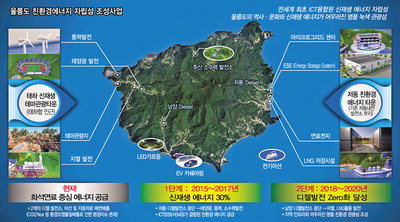Findings of Pohang earthquake causes halt energy project on Ulleung Island

Findings that geothermal power plant construction in Pohang led to the city’s 2017 earthquake have halted a self-sufficiency energy project on Ulleung Island that was heavily reliant on geothermal energy. The photo shows the project outline.
SEOUL, Mar 25, 2019, Hankyoreh. The aftereffects of a government investigation report on Mar. 20 attributing a November 2017 earthquake in Pohang to the construction of geothermal power plant are spilling over to Ulleung Island, which previously nursed ambitions of achieving energy self-sufficiency through geothermal power, reported the Hankyoreh.
On Mar. 21, North Gyeongsang Province announced that a decision had been made to “liquidate Ulleung Enerpia, the special purpose corporate jointly formed by the private sector and government for the Ulleung ‘self-sufficient island’ project.”
“After holding concrete discussions with major shareholders at a board meeting on Mar. 22, we plan to begin liquidating the corporation in earnest as of April,” it said.
In 2014, Ulleung Island launched an “eco-friendly energy self-sufficient island” project that involved replacing diesel with geothermal, solar, wind and hydrogen energy as sources for the power used by its roughly 10,000 residents. Named as a model of energy self-sufficiency in a July 2014 government report on “plans for creating new industries in response to climate change,” the self-sufficient island project involved a total investment of 268.5 billion won (US$237.6 million) between 2015 and 2016 to build new and renewable energy power facilities to produce 68,000MW each year on the island. While fuel cells previously accounted for a large portion of the energy, that amount was drastically reduced over associated operating costs, and the percentage of geothermal energy was increased to 87% of total power generation.
But in the wake of the recent government announcement identifying a geothermal power plant as a trigger of the Pohang earthquake, the entities behind the project – North Gyeongsang Province, Ulleung County, and the Korea Electric Power Corporation (KEPCO) – tentatively concluded that the project should be halted.
“Ulleung Enerpia, which had its offices in Ulleung County’s Do neighborhood, already shut down two weeks ago,” noted Ko Byeong-cheol, head of the county’s eco-friendly energy team.
“The project had already been going downhill following staff cuts and downsizing in the wake of the Pohang earthquake on Nov. 15, 2017, and it’s now entered the liquidation stage,” Ko said.
Ulleung Enerpia is a special purpose corporation established in September 2015 by North Gyeongsang Province, Ulleung County, KEPCO, LG CNS and Dohwa Engineering with an investment of 26.8 billion won (US$23.72 million). The company’s liquidation three years and six months later translates into loss of the 11.6 billion won (US$10.27 million) previously spent on services, operation and personnel. The amount includes 2 billion won (US$1.77 million) spent by the province and 200 million won (US$176,997) spent by the county.
By Koo Dae-sun, Daegu correspondent